On April 12, 2020 I wrote about 77 still standing classic lampposts, most from the early 20th Century, that have been recognized by the Landmarks Preservation Commission. Today, I’ll be doing something a bit different as I present a few dozen lamps that have been lost in recent memory (by recent, I mean the past 40 years or so). In 2017, Bob Mulero published The History and Design of New York City Streetlights, Dorrance Publishing, the only volume I am aware of that deals exclusively with NYC lamppost design. He also provided a few dozen black and white photographs of classic poles around town, many of which have been lost since then.
There is no shortage of NYC photography over the decades; my bookshelves are groaning, and in one case, collapsing, with NYC photography books. But these photographers — that include the now nameless throng that snapped photos of NYC properties for the 1940 Municipal Archives, now in full view online, as well as surveyors and historical photographers such as E.E. Rutter, Eugene Armbruster and Percy Loomis Sperr, who have influenced my work to a large degree, did not make lampposts, or any form of street infrastructure like stoplights or elevated trains, major players in their work. Topography and real estate properties were their primary focus. Only three photographers I know about have sought out lampposts for research and study, and I am one of them.
Bob Mulero is a resident of Independence Plaza in lower Manhattan and works for Metro-North, the commuter railroad. Besides his interest in lampposts, he is a toy enthusiast and collector. He has been taking photos of NYC lampposts since 1978, and has amassed a collection numbering in the thousands; though I’ve always been a lampophile, I did not begin taking photos of them in earnest until 1998, the year Forgotten NY began initial production, and by then, some of the choicest historical lamps around town had been removed. Bob is a regular on Forgotten NY tours and, if anything, his technique has massively improved in those 21 years I’ve been doing them. I often tell Bob as well as the other of NYC’s lamppost chroniclers, Jeff Saltzman of Jeff’s Streetlite Site, “before us, there was nothing, and after us, there will be nothing” as far as describing, categorizing and admiring NYC lampposts is concerned.
The photos you see here on this page are in color versions in Bob’s book, linked above, as well as hundreds of other examples. Where I can here, I’ll try to provide more details and context about the lamps and the scenes you see them in: many of these scenes have changed irrevocably.
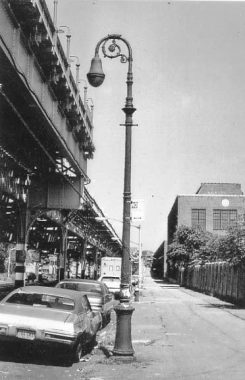
10th Avenue at East 207th St., Inwood
10th Avenue and its northern iteration, Amsterdam Avenue, is among the longest north-south avenues in Manhattan, running from West Street at about West 14th all the way to Fort George Hill; in 1890, the section above West 59th was renamed Amsterdam Avenue and given a fresh set of house numbers. However, in Inwood, there’s a 9th and 10th Avenues that are disconnected with their southern cognates; 10th Avenue runs along the west side of the 207th Street subway yards and is shadowed by Manhattan’s only remaining elevated train, carrying the #1 to Van Cortlandt Park.
It is a Type 1 BC, the oldest existing variety of “bishop crook” lampposts. They are marked by garlands on the shafts as well as “ladder rests” below the crown.
According to Bob the post was removed in 1982; the early 80s were bad for NYC classic lamps, as many disappeared during those years.
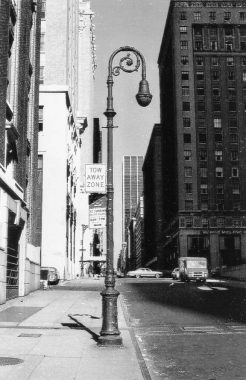
East 46th Street at Park Avenue
This Type 1 BC was removed in 1979; the block is now dominated by green 34th Street Partnership lampposts. The masonry building to the immediate left, 237 Park Avenue, was built in 1905 and given a top to bottom remake in the 1980s; its owners feel that Park Avenue is a more prestigious address than East 46th Street. If you squint, you can see one of two extant “Wheelie” stoplights at Park Avenue and East 46th. They no longer carry stoplights and are now decorative signposts, protected from demolition by Landmarks.
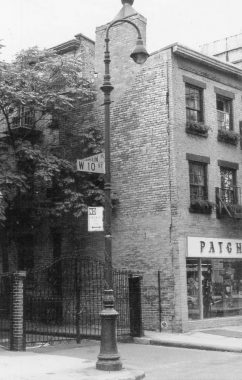
West 10th Street at Patchin Place
I’ve mentioned this landmarked post, a Type 1 BC crook, at Patchin Place in the Village before; it’s been moved across the street to a driveway at the Jefferson Market Library, with a retro bishop crook replacing it. When Bob Mulero shot it in 1978, it was in its original spot, but had already lost its crown scrollwork.
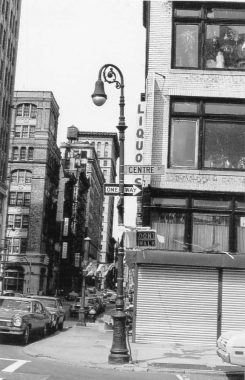
Centre and Walker Streets, Chinatown
Another classic Type 1 BC Bishop Crook, in another photo from the late 1970s. This one was demolished long ago: however, a couple of block north, at Centre and Grand streets, you can find an existing 1 BC.
If you look carefully, you can see an unusual street vent and a thick, high pressure fire hydrant. Most of the HP hydrants in Manhattan and in Coney Island were eliminated by 2000.
The 8-story building on the left, at Lafayette and Walker Streets, is the Avildsen Building, constructed between 1907 and 1910, by the Howells and Stokes architectural partners. Stokes was the formidably-named Isaac Newton Phelps Stokes, a polymath who was not only an architect but an avid historian. His 6-volume Iconography of Manhattan Island, published from 1914-1928, is a comprehensive study of Manhattan Island’s history from 1498-1909. It’s available at the link.
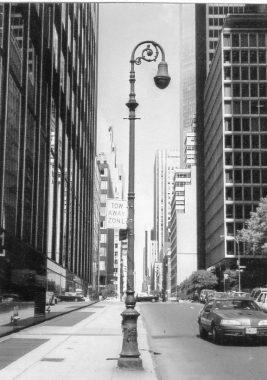
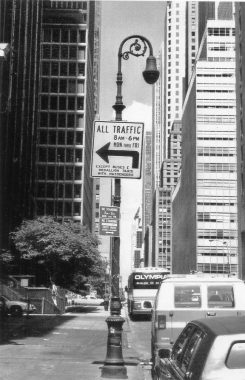
This pair of Type 1 BC posts could each be found on East 48th and 49th, respectively, between Park and Lexington Avenues. Each disappeared around 2000, give or take a year. They were the sole lampposts on the block, which probably had something to do with the vast Grand Central Terminal underground trackage. Each was replaced by a retro version Type 24 A post. The East 49th Street post faces the former Waldorf-Astoria Hotel.
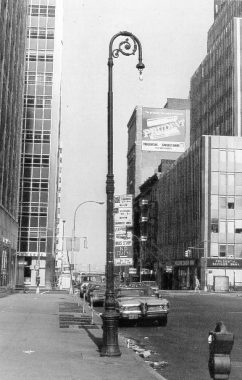
Park Place at Church Street
Type 24A bishop crooks were the most numerous type found on NYC streets. They were first installed in the 1920s and were used through about 1944, when they were replaced by the somewhat taller Type 24A-W, which were cheaper to make with wrought iron. Modern retro versions, first used in 1980, are based on the 24A with the addition of a shaft garland (a feature of the type 1 BC).
This one, which had lost its Bell fixture, was on Park Place just east of Church Street. It has also lost its midshaft capital (see the above posts to see what I mean). That corner until about 2000 or so featured a pair of nonstandard stoplights, much different from the usual type used in NYC. They can be seen in the background.

Whitehall and Pearl Streets
This Type 24A post, which is also missing the shaft capital, was on the NW corner of Whitehall and Pearl Streets. In the 1970s, there was room for parking lots in lower Manhattan, but real estate is much more expensive these days. The glassy tower 33 Whitehall (Broad Financial Center) replaced the lot in 1986.
Note the fire alarm and indicator light. This is one of the old-style alarms that was attached to the lamppost shaft, and likely shared wiring.
Famed author Herman Melville was born nearby, at what had been #6 Pearl Street.
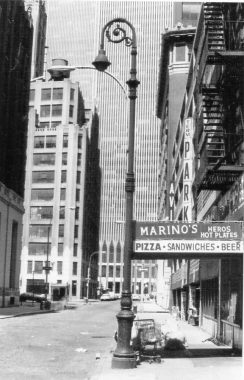
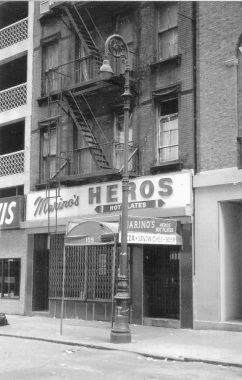
109 Washington Street
I really should have included this Type 24A at 109 Washington Street between Rector and Carlisle. It’s still there, though it wasn’t on the Landmarks list from 1994 I had consulted. It may have been added since. Marino’s Heros is now an empty storefront, and the World Trade Center, which dominated the background in the early 1980s, has of course been gone since 9/11/01.
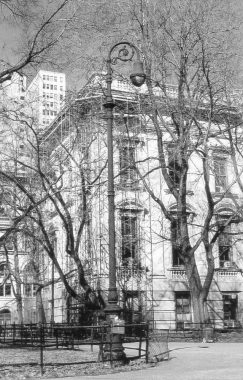
City Hall Park
City Hall Park, a good deal of which has been shuttered to the public since the terrorist attack, is NYC’s biggest repository of Type 1 BC posts. In the early 1980s Bob Mulero obtained this shot of an unaltered Type 1. In the 1990s, the park was renovated top to bottom, including the lampposts, which were altered considerably, adding pendant ornaments that were features when the posts originally appeared in the 1910s.
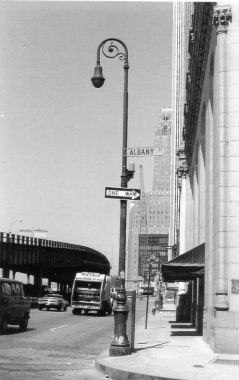
West and Albany Streets
Plenty has changed from 1978, when this photo at West and Albany Streets downtown was taken. This is a Type 24A-W post, which is discernable from earlier type 24A bishop crooks by its unadorned shaft and simpler, cast iron scrollwork at the crown. The elevated road at left is the West Side (Julius Miller) Highway, which had closed in 1973 when a truck fell through the roadbed after years of neglect. It took the city nearly 15 more years to completely demolish it.
The building on the right side, 90 West Street, still stands. It is a limestone and terra cotta tower designed by Cass Gilbert (in a sort of dry run for his 1912 Woolworth Tower a few blocks away), as it opened in 1909.
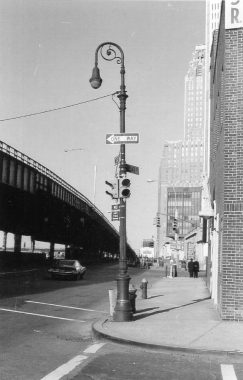
West and Cedar Streets
One block north of Albany, at Cedar Street, stood another Type 24A-W. This one had a pair of Ruleta traffic signals. The brick building on the right is gone and the corner is now part of the elevated plaza at Liberty Park. The crook was replaced in 1983.
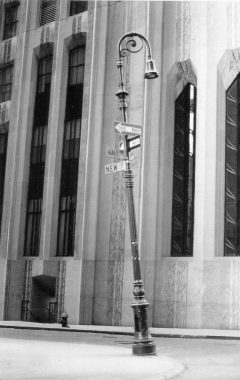
#1 Wall Street at New Street
The Bank of NY Mellon, originally the Irving Trust Company tower, rose at #1 Wall Street in 1932, the deepest Depression year, designed by Ralph Walker. It backdrops this lost Crook, which was already listing and missing its glass reflector bowl in the 1980s. Both Wall and New Streets are closed to vehicular traffic in 2020.
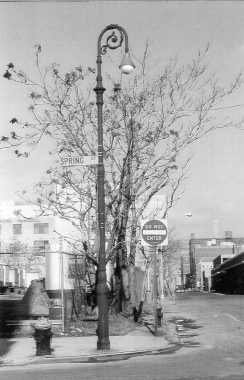
Washington Street at Spring Street, SoHo
This was actually a hybrid post combining a regular Type 24A crown and upper shaft with a type 6 BC base (see below). The empty lot has been replaced by a gi-normous Department of Sanitation garage. If you were to walk east on Spring Street you would encounter one of NYC’s oldest bars, the Ear Inn.

Bleecker Street at Mercer Street, Greenwich Village
It’s amazing this post was still standing in 1977, when it was finally removed. It seemed to have lost both its incandescent bulb and also its fire alarm indicator bulb, but this was a time of extreme deferred maintenance in NYC under the Beame administration.
This is a complete Type 6 BC post, with its trademark narrow base. As we’ll see below, the Type 6 also had different scrollwork in its crown. Type 6 BC’s also had the ladder rest, same as their contemporaries, Type 1 BC.
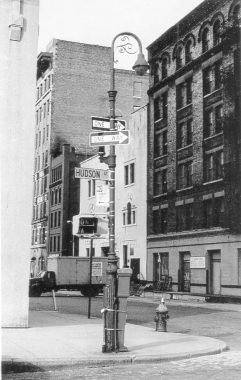
Hudson and Hubert Streets, Tribeca
Here’s a complete Type 6 BC, with its unusual scrollwork in the crown. These posts used to be workhorses on side streets in NYC, especially those with narrow sidewalks that couldn’t accommodate Type 24A wider bases. You can see the attached fire alarm, though this one needs some bands to keep it upright. Next to the pole is a squat high pressure fire hydrant. This post was torn down in 1982. The Romanesque 151 Hudson, built in 1894, can be seen at right.
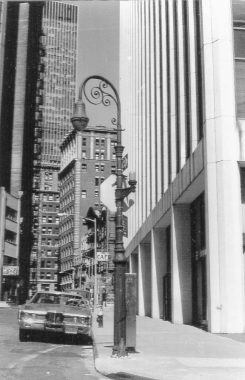
Pearl Street at Hanover Square
This Type 6 BC is another lamp that I’m frankly amazed lasted as long as it did. Bob Mulero indicates that it was finally torn down in 1982. It’s shorter than most bishop crooks, since it had to fit under an elevated train before 1942. On the right is 10 Hanover Square, a 23-floor office building once home to Goldman Sachs; it was converted to residential/commercial in 2005. An L-shaped Downtown Alliance lamp stands there in 2020.
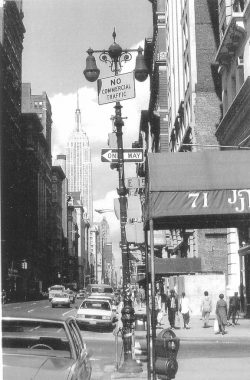
71 5th Avenue at East 15th Street
The oldest variety of electric streetlamps in NYC was the Type 3 Twin, introduced in 1890 and modified into this form in 1911. They’re quite ornate with intricate scrollwork on the top shaft and a narrow, fluted base. Until 1938, give or take a year, these posts used a number of different lamp fixtures before settling on the Bells you see here. Beginning in the 1930s, the Department of Traffic (overseen by the NYPD) was no longer producing this particular style, and thus when a post failed it was replaced by a type 24 Twin (see below). Their primary use was on 5th Avenue, but Type 3 twins also found homes on streets like 7th Avenue and 34th Street.
Finally, in 1965, 5th Avenue’s Twins were all replaced by bronze, twin-armed Donald Deskey posts. Since the Deskeys themselves were no longer made after the 1980s, they have been replaced by a variety of lamps, many of them 34th Street Partnership posts (see link above). Today only a handful of the 5th Avenue Type 24 twins and Deskey specials remain.
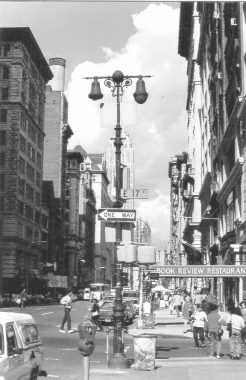
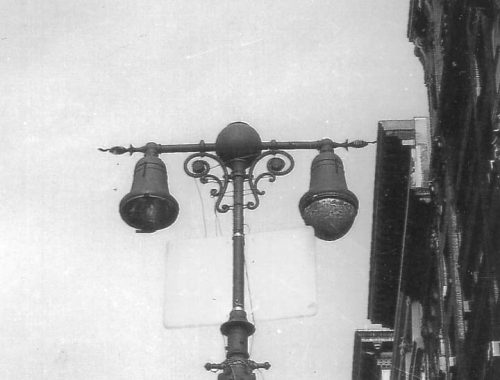
95 5th Avenue at East 17th Street
Also hanging tough on 5th Avenue at East 17th until the mid-1980s was this nearly identical Type 3 Twin. However, while its original end-of-shaft coils were retained on this number, the apex coil above the center ball has fallen away or been removed.
Today, the only Type 3 Twin remaining is at Broadway and East 23rd at Madison Square, and even that one is a hybrid post with a type 1 BC base. Sick transit, Gloria!
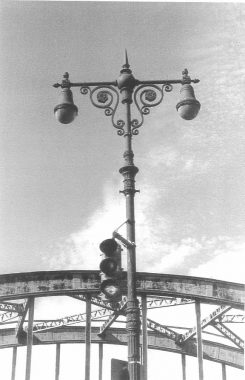
Canal Street at West Street
This is a Type 24 Twin, the commonest variety in NYC, but with a couple of variations that include the “German helmet” finial, and larger finials than usual at the lamp fixture sockets. This post was located at the fairly wide triangle intersection at Canal and West; the Twin was removed in the 1980s, and in the 2000s, the wedge was landscaped into the present Canal Park.
In the background is an iron trestle supporting the Miller (West Side) Highway. It was engineered so pillars would not impede Canal Street traffic. The highway was closed in 1973 and demolished in the 1980s.
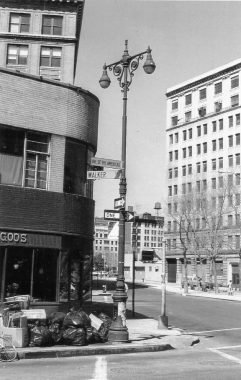
6th Avenue at Walker Street, Tribeca
I’ve already shown you this landmarked post, as it’s on FNY’s previous post about landmarked lampposts, but his time I wanted to show you Bob Mulero’s shot of it from the 1980s when it had two incandescent Gumball lamps instead of the Holophane buckets it has today. In the late 1930s, Bell and Gumball fixtures took over NYC lamps, with the Bells getting the lion’s share of the action; the Bells had a conical variant I call the “junior Bells.” (You can tell I like this stuff.) In the 1940s that trio was joined by the Westinghouse AK-10 “cuplights” which proved so versatile they dominated into the 1960s.
It’s a standard Type 24 Twin, but it’s lost its shaft capital and parts of it are rusting seriously despite a recent paint job. The post is now missing its top finial.
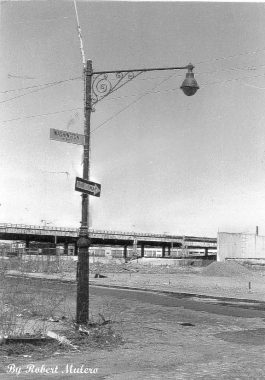
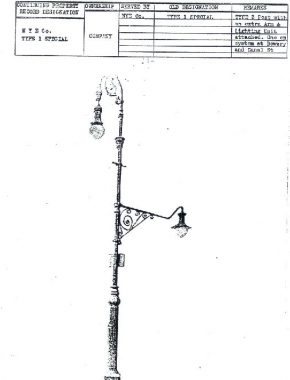
Before Independence plaza, the housing complex, was constructed in the former Washington Market area between West, Greenwich, Chambers and Hubert Streets in the early 1980s, there was an intermediary period of about a decade after the market’s buildings, as well as other local businesses and residences, were torn down and the streets were barren with empty, weedy lots punctuated by a few straggling structures. It’s hard to believe it these days when just about anywhere in Manhattan was prime real estate: but there were acres upon acres of empty territory just north of the USA’s financial capital. To get a good look at what this area used to look like, see Danny Lyon’s photo book called The Destruction of Lower Manhattan. It depicts these blocks just after they closed and just before they were demolished.
Until Independence Plaza was built, old species of streetlamps could still be found here and there. The lamp you see above at the former intersection of Washington and Chambers Streets was the last of its type remaining, a Type 6 Special Post. This is actually an altered version because these posts were usually crowned by a bishop crook lamp and they were used at elevated trains, with the lower shaft lighting under the el and the bishop crook the intersecting street. Here’s a similar example in 1940 at West 3rd and Macdougal Streets. The post was demolished about 1982.
In this case the “crook” had been lopped off and the lower shaft retained. Washington Market buildings often had protective sheds extending over the sidewalk; perhaps this mast, at a 90″ angle from the shaft, extended underneath one of those awnings.
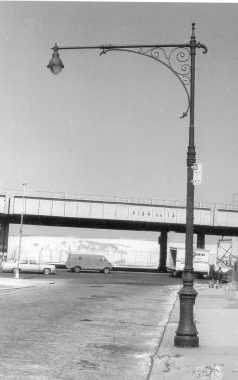
Murray Street at West Street
By far the most numerous post employed to light wide streets was the Type 24M , popularized as the “Corvington” by Jeff Saltzman. They were first introduced in the 1910s. The scrollwork varied in the early models before standardizing by the 1930s. This one stood on Murray Street in the Washington Market area.
Though Murray Street still extends west in this area, when Battery Park City was constructed in the 1990s, surveyors changed its orientation so it now angles southwest, directly into the housing complex and thus, this section of Murray no longer exists. A skyscraper, 111 Murray, and a retail complex now occupy this space.
On the West Side Highway overpass, a sign for Pier 18 can be seen. The west side of Manhattan was still open for shipping in the 1980s.

Barclay Street at West Street
Another surviving Type 24M, this one at Pier 16 at Barclay Street. Note the subtle differences in the metal scrollwork on this post and the one shown previously. 125 Barclay, at right, still stands.
Today, Manhattan’s only set of surviving early 20th Century 24Ms are on Morris Street on either side of the Brooklyn-Battery Tunnel exit, though Corvingtons have been extensively revived as retro versions all over NYC. You’ll find them on Columbus Avenue, Morris Park Avenue in the Bronx, Grand Avenue in Queens and many other locales.
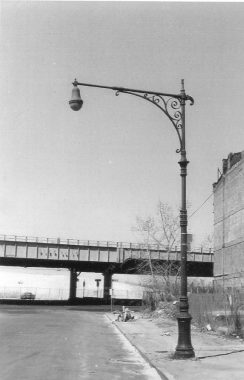
Warren Street at West Street
Another Washington Market surviving Type 24M. As the area slowly came to life in the 1980s, the building at right was a last survivor of the old days, remaining in place into the 2000s. Today, a high-rise, 200 Chambers, occupies the site. It features a downtown location of the Palm steakhouse.
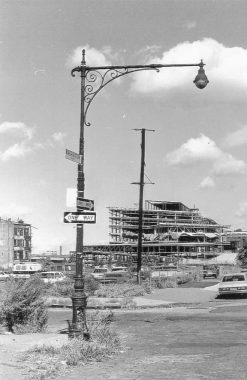
Washington Street at Murray Street
In a photo emblematic of the 1970s desolation of the Washington Market area after the demolitions had been completed, the Belgian blocked streets are weedy and if this was out west, you wouldn’t have been surprised to see tumbleweeds — in the USA’s biggest city and the capital of capitalism. Change is afoot, though. The skeleton in the distance is the first building of Independence Plaza under construction in the 1980s. Bob Mulero is a current resident.
This short piece of Washington Street, as well as an adjoining parking lot, survived here until about 2010. A giant retail complex/office building that includes Bed, Bath & Beyond and Barnes & Noble (remember bookstore supermarkets?) now occupies this space.
Can retail brick and mortar shopping thrive after the coronavirus crisis? We’ll find out.
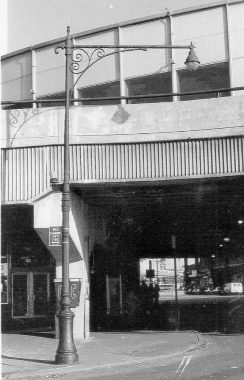
South Ferry
I was quite familiar with this Type 24M as a child. At times my parents and I wold ride the Staten Island Ferry to St. George and of course, I noticed this beautiful specimen, complete with fire alarm light bracket, as we were boarding the boat. Through the tunnel under the old ferry terminal (it burned in the 1990s, and a new one opened in 2005) we can see South Street, which runs along the East Side-FDR Drive.

Dyker Park Golf Course
I have never played golf; it’s expesive, all those clubs and bags, and whacking a small white ball around a huge expanse, trying to get it into 18 holes, would be a frustrating experience for me. However, I’m quite familiar with the Dyker Park Golf Course, which isa few blocks away from my ancestral apartment building in Bay Ridge. There’s a short, crescent shaped road, DeRussy Drive, connecting 86th Street and 7th Avenue, and patrons can drive up to the clubhouse and park their cars while they whack a few rounds.
Throughout my childhood and young adulthood, I was quite aware of four Type G posts that could be found along the drive. Two of them lit the parking lot and Bob Mulero found one in 1982. These poles survived until about 2000 and I got some photos of them for FNY, as well. They kept their old Gumball fixtures, but by the time I had at them, they weren’t working anymore. The city replaced them with new Type B park posts in 2000.
The Type G, meanwhile, is basically a shorter version of the Type 24M that was primarily used in parks and on secondary streets.
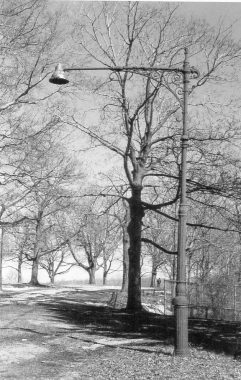
Van Cortlandt Park, Bronx
In the 1980s, Van Cortlandt Park, which abuts Kingsbridge and Riverdale in the Bronx, had a number of disused type Gs that had burned out by the time Bob Mulero found them during the infrastructure crisis of the 1980s. All have been replaced by smaller type A posts.
Today the largest grouping of working type Gs can be found in the semiprivate Stuyvesant Town complex.
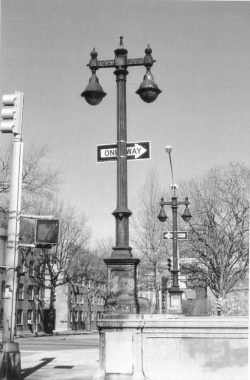
7th Avenue (Adam Clayton Powell Blvd.) and West 153rd Street
These posts, which were considerably modified, losing their Westinghouse AK-10 cups in 2011, illuminated a ramp connecting ACPB to the Harlem River Drive. It’s a variety that I was again surprised survived as long as they did. They are known as “Special Iron Standards.”
A grouping still in their original form, with 8-paned lantern-style fixtures, can be found on the Riverside Drive viaduct that spans West 158th Street a few blocks west of here.
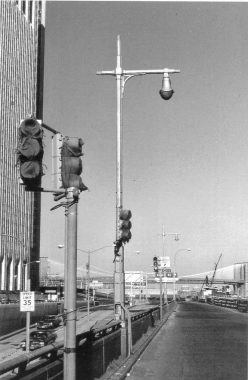
South Street at South Ferry
There is a vehicular tunnel underneath Battery Park that connects West Street (and formerly the West Side Highway) with the East River Drive, that runs on Manhattan Island’s East River waterfront, becoming Franklin D. Roosevelt Drive at Montgomery Street. At South Ferry, South Street runs on both sides of the tunnel for a few blocks. In the 1930s, that’s where a pair of short-armed Triborough Bridge posts were positioned.
The Triborough Bridge was constructed between 1928-1936, spanning the East river, Harlem River and Bronx Kill and connecting Manhattan, Queens and the Bronx. A design element employed on the tower finials and the lampposts lighting the bridge were stepped figures echoic of Manhattan’s zigguratted skyscrapers. In 1916, legislation was passed mandating that setbacks were to be designed on upper floors to allow more sunshine to reach the street. However, modern skyscrapers don’t seem to be following the mandate.
These posts, designed exclusively for the bridge in longer-masted versions, could also be found on Randalls Island (see below). New retro versions have appeared on selected streets in the Bronx (Elton Avenue) and Queens (Broadway, Ditmars Boulevard, Jamaica Avenue). They also can be seen in Hudson River Park.
This pair made it all the way to 1985 before finally being removed.
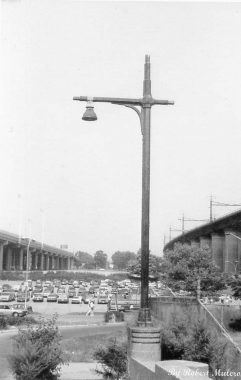
Randall’s Island
By the time Bob Mulero got a photo of this Triborough post on a bridge off ramp onto Central Drive on Randalls Island, it was pretty much rusted through during NYC’s Age of Neglect in the 1980s. It was removed soon after.
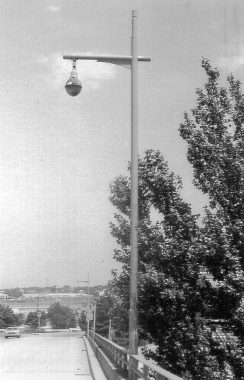
LaGuardia Airport
A Whitestone Bridge post holding a Gumball fixture lights an approach road bridged over the Grand Central Parkway. These poles were designed for the Whitestone Bridge in the 1930s and quickly became ubiquitous on area parkways and later, expressways well into the 1970s, finding homes on the Brooklyn-Queens Expressway, FDR Drive, and many other roads. Most were replaced by the 1980s, though some survive on Brooklyn Bridge approach roads in Manhattan and Brooklyn.
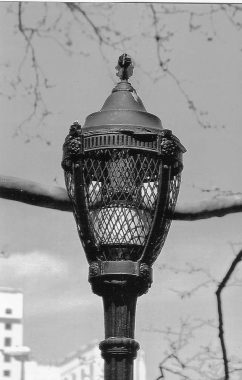
Type B “Cage”
Though Type B posts are ubiquitous in NYC parks, they’re also among NYC’s oldest, first appearing in the 1910s, designed by architect Henry Bacon. They have carried numerous forms of post-top luminaires, but the one I recall from my youth is the “cage” variety, with a metal shield preventing the vandalism that was seriously compromising earlier clear glass holders. Translucent plastic, presumably vandal-proof, is used these days.
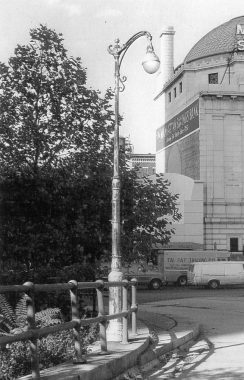
Manhattan Bridge at Bowery
Type F posts with their complicated mast metalwork were workhorses illuminating Manhattan side streets beginning with their first few iterations in the 1920s. There a number of different varieties and sizes, but the one seen here eventually won out. They also found a home on vehicular and pedestrian bridges, such as the Manhattan Bridge pedestrian path. This one had gone to lamppost heaven by 1990.
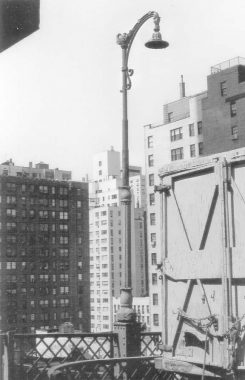
Queensboro Bridge
The north side of the Queensboro Bridge (which has three names; I don’t use the other two) has a pedestrian/bicycle path, and until about 1980, Type F posts with radial wave fixtures employing incandescent bulbs feebly lit it. Much brighter modern lamps do the trick today.
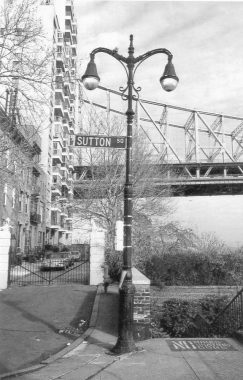
Sutton Square (East 58th Street)
Until I found this post in 1998, I was unaware that Type F posts came in Twin versions (originally, bishop crooks and Type 24M Corvingtons didn’t, though they do in retro versions). So I was frankly amazed when I found this one, that Bob Mulero already knew about in the 1980s when he got this photo. The shaft of this post shows up in publicity photos of the woody Allen classic Manhattan.
Unfortunately it was torn down and a retro bishop crook was installed in 2000.
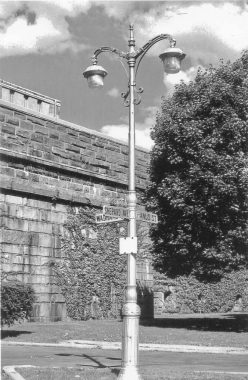
SUNY Maritime College (Fort Schuyler)
When the Sutton Square Type F Twin was eliminated, I thought I’d seen the last of them, but then I visited SUNY Maritime College in 2005 and was I ever amazed to find this example on Shepard Avenue. Bob had found it as well. Unfortunately it was apparently on its last legs and disappeared soon after that.
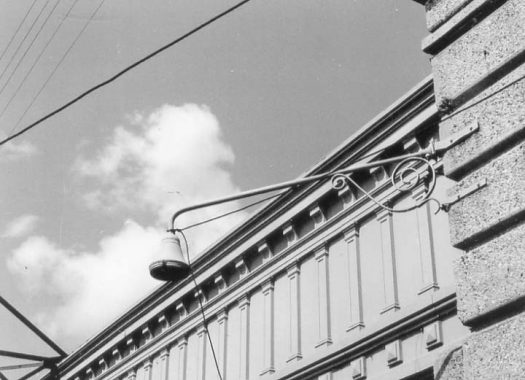
Queens Boulevard at LIRR, Woodside
Scrolled pipe masts like this used to carry incandescent bulb fixtures, most often radial wave lamps, from about 1915 well into the 1960s on telephone poles and under bridge abutments in “outer boroughs” i.e., not Manhattan. They came in two lengths, this being one of the longer ones. It is carrying a “junior bell” fixture. By 1980 it had lost its bulb and soon after, had disappeared completely. Only one of them survived until fairly recently, way up in Riverdale at Palisade Avenue and West 254th (no doubt since the Department of Transportation forgot it was there). It was replaced in the early 2010s.
Some of the shorter masts, though, have served to mount fire alarm indicator lamps. They have all been decommissoned, but many of the masts remain in place.
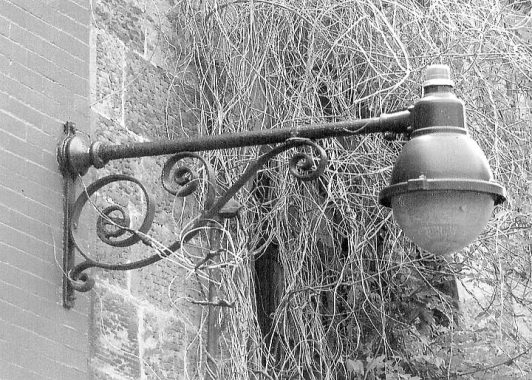
Grace Court Alley
Brooklyn Heights is NYC’s first Landmarked District, bestowed on it in 1965—amazingly, the first was not in Manhattan. It’s Brooklyn’s oldest neighborhood, which in the colonial era originally clustered around the Brooklyn ferry landing on Old Fulton Street and spread south. It became a working class and later on, a ritzy enclave. The area has retained some if its stable walks, which are now alleys between the main east-west streets. One of these is Grace Court Alley off Hicks Street.
This is a wall lamp featuring a scrolled mast (which has a bit of extra filigree). When Bob Mulero found it, there was a Westinghouse AK-10 cup there; it has been replaced at least 3 times since and now carries a charlmess, insectile LED beacon. At least it’s there.
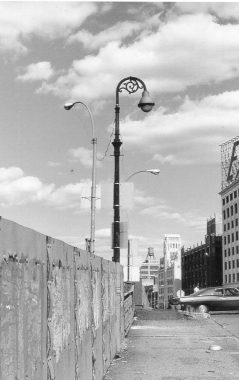
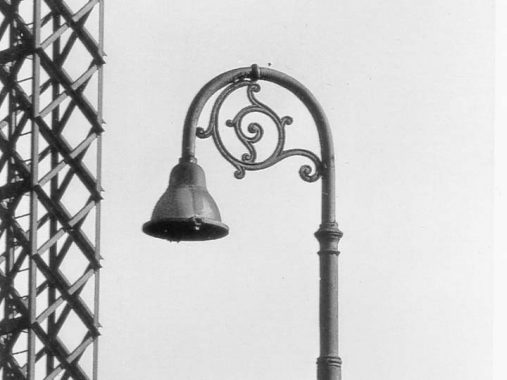
Sunnyside Yard Bridges
The vast Sunnyside Train Yards dominate western Queens, servicing passenger trains serving the Long Island Rail Road, Amtrak, Metro North, and New Jersey Transit, though the two latter do not make passenger runs in Queens. Vehicular traffic traverses the yards on the 21st Street, Thomson Avenue, Honeywell Street and 39th Street Bridges. Until 2000 or so these bridges were rusting, falling apart and collapsing, due to the Era of Neglect of the 1980s.
These bridges still had original fencing and in many cases light posts from their original construction in the 1910s, with only “modern” incandescent fixtures from the 1940s appended. The scrollwork was of a simplified variety not used on NYC streets in general.
At length the bridges were shored up with modern lighting and in the case of Honeywell and 39th Streets, completely replaced, and so these relics are no more.
Check out the ForgottenBook, take a look at the gift shop, and as always, “comment…as you see fit.”
5/3/20

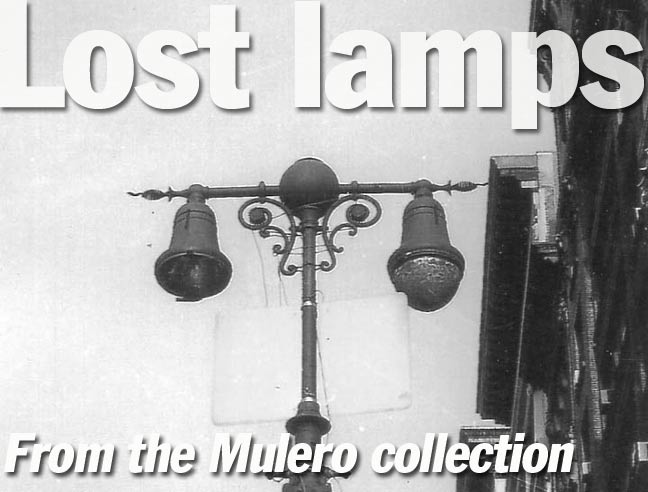
3 comments
The photo captioned “Brooklyn Bridge at Bowery” should read “Manhattan Bridge at Bowery.”
OK
Wonderful writing style. Excellent pictorial tour, chock full of information. Such nostalgia! Thank You.